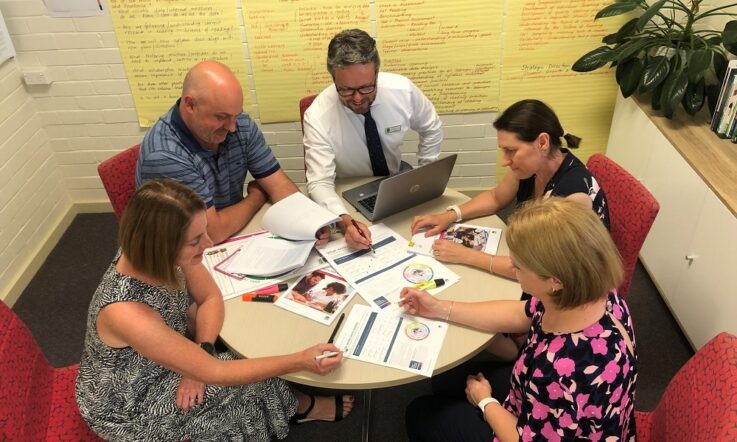Having high expectations for all students is important at all levels of schooling. At Auburn Girls High School in Auburn, New South Wales, students are supported to achieve the high expectations teachers hold for them.
Anna Tsoutsa is in her sixth year as principal at the school and says that during this time the entire school community has worked towards building a collaborative, supportive culture which has high expectations for each student.
‘With regards to setting up the conditions to allow the girls to be the best version of themselves, we’re talking about their learning, there’s a focus on learning, there’s a focus on good discipline and expectations that the girls do follow the school’s values – which are respect, responsibility and personal excellence,’ she tells Teacher.
‘From the students’ point of view, what we keep talking about is our expectation is that they are the best version of themselves and they give their personal best in all areas. We, the teachers and the staff, we set up the conditions to allow them to achieve that.’
Auburn Girls High School is a partially selective school, meaning one class in Year 7-10 is selected from an external Department of Education test. They also educate three classes of students with disability, as well as students who have been enrolled from local areas. Across the school, 98 per cent of students are from a non-English speaking background.
Impact of high expectations on student learning
Staff have implemented a number of strategies to support students to improve in their learning. Tsoutsa says explicit teaching, for example, has proven to be really important in their school context, particularly when it comes to literacy.
‘… We’ve got girls that come from a home where English is not the language spoken, then you’ve got limitations in even the most competent student and high-performing student in aspects of literacy, especially in vocabulary and inference, so we teach that explicitly,’ she explains.
Positive education with a particular focus on resilience has also been effective in supporting students. Especially as they worked through continuing learning during the pandemic, Tsoutsa says the fact students understood the strategies they could apply when it comes to resilience has helped maintain the culture of high expectations.
‘The outcome has been that with all the many programs that we have put into place – not only curriculum, but wellbeing – it has meant that the girls have an understanding of what it means, what high expectations mean … (and the teachers as well), that every student can learn, every student can move forward and achieve the best possible outcomes for themselves.’
A whole-school approach to high expectations
To successfully embed this culture of high expectations across the school, Tsoutsa says it’s important both students and staff model the same expectations and values. This includes their low tolerance for unacceptable behaviour. Tsoutsa shares that a very strong discipline policy is embedded in the school to further communicate to students that they are expected to behave respectfully and responsibly so they don’t interfere with the learning of other students.
‘If you don’t behave in a way that allows positive modelling then you cannot get the positive outcomes from the girls. So I expect every member of staff to lead by example,’ Tsoutsa adds. ‘They also need to model the same sorts of behaviour that we expect of the girls: punctuality, respect, and giving their personal best.’
Sustaining a culture of high expectations
Tsoutsa says the most challenging task she overcame while developing this culture of high expectations was ensuring that all staff were on board and that they had a firm understanding of the impact that this culture would have on student learning.
Therefore, an important part of successfully sustaining a culture of high expectations has been to take a collaborative approach. The school vision to be a centre of excellence in girls’ education was established as a whole school, which Tsoutsa says has helped teachers understand the culture they are helping to create and sustain.
Staff have also worked collaboratively with the Centre for Education Statistics and Evaluation What works best toolkit. The toolkit encourages school staff to reflect on their current practice for each of its eight themes, and identify areas for improvement. The eight themes are: high expectations; explicit teaching; effective feedback; use of data to inform practice; assessment; classroom management; wellbeing; and, collaboration.
‘I’ve tried very hard through professional learning to make the how we do it achievable and to make sure they work with me to come up with the strategies that are derived from What works best, applied to our context. And then once it’s done, we share, we celebrate together, that’s really important,’ Tsoutsa reflects.
‘So it’s that continuous cycle of “we work together, it is our common goal”. And we’re working towards the same thing, which is ultimately a happy school where kids are working towards their personal best, where teachers are happy to be here and to teach and to do their best and be proud of their practice and be proud of their students.’
As a school leader, consider the eight toolkit themes mentioned in the article: high expectations; explicit teaching; effective feedback; use of data to inform practice; assessment; classroom management; wellbeing; and, collaboration.
Which are particular strengths in your school and where are the areas for improvement? Think about the last time you addressed each theme with staff. Do staff have a consistent understanding of what each theme means for your own school context?



